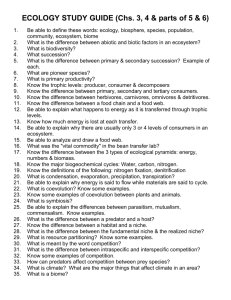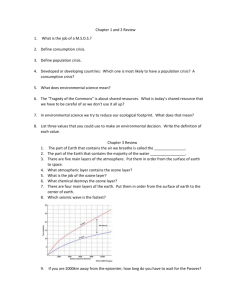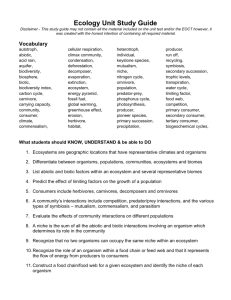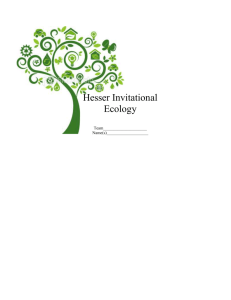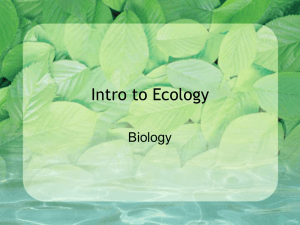BIO 1C Study Guide 3: short distance flow, xylem and phloem flow
advertisement
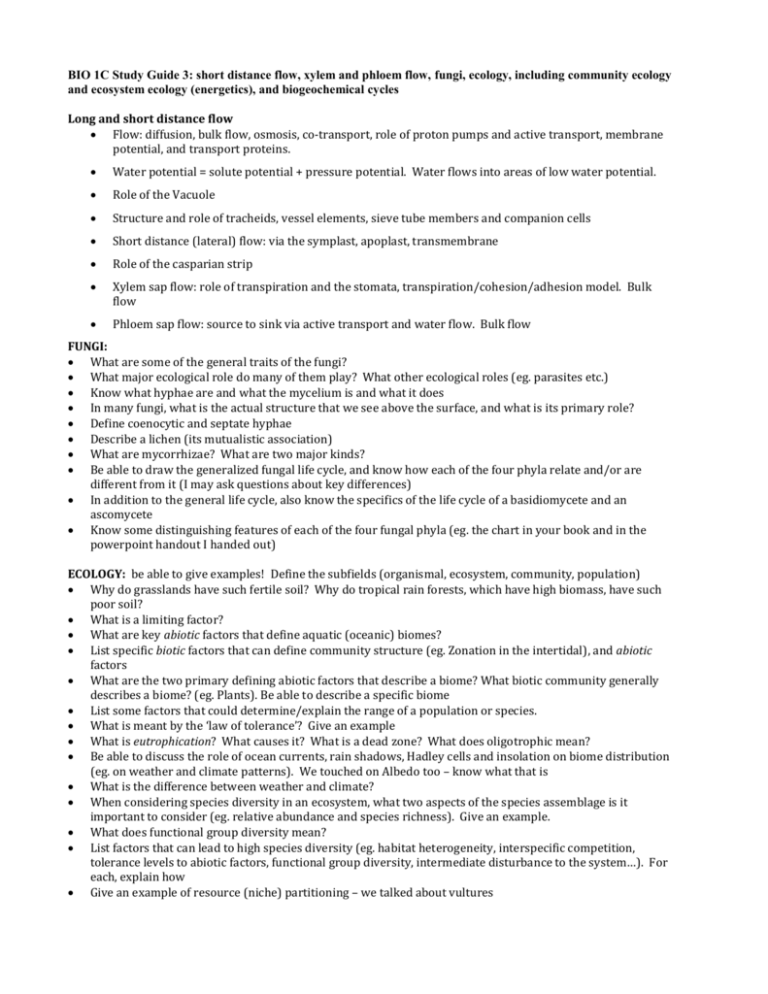
BIO 1C Study Guide 3: short distance flow, xylem and phloem flow, fungi, ecology, including community ecology and ecosystem ecology (energetics), and biogeochemical cycles Long and short distance flow Flow: diffusion, bulk flow, osmosis, co-transport, role of proton pumps and active transport, membrane potential, and transport proteins. Water potential = solute potential + pressure potential. Water flows into areas of low water potential. Role of the Vacuole Structure and role of tracheids, vessel elements, sieve tube members and companion cells Short distance (lateral) flow: via the symplast, apoplast, transmembrane Role of the casparian strip Xylem sap flow: role of transpiration and the stomata, transpiration/cohesion/adhesion model. Bulk flow Phloem sap flow: source to sink via active transport and water flow. Bulk flow FUNGI: What are some of the general traits of the fungi? What major ecological role do many of them play? What other ecological roles (eg. parasites etc.) Know what hyphae are and what the mycelium is and what it does In many fungi, what is the actual structure that we see above the surface, and what is its primary role? Define coenocytic and septate hyphae Describe a lichen (its mutualistic association) What are mycorrhizae? What are two major kinds? Be able to draw the generalized fungal life cycle, and know how each of the four phyla relate and/or are different from it (I may ask questions about key differences) In addition to the general life cycle, also know the specifics of the life cycle of a basidiomycete and an ascomycete Know some distinguishing features of each of the four fungal phyla (eg. the chart in your book and in the powerpoint handout I handed out) ECOLOGY: be able to give examples! Define the subfields (organismal, ecosystem, community, population) Why do grasslands have such fertile soil? Why do tropical rain forests, which have high biomass, have such poor soil? What is a limiting factor? What are key abiotic factors that define aquatic (oceanic) biomes? List specific biotic factors that can define community structure (eg. Zonation in the intertidal), and abiotic factors What are the two primary defining abiotic factors that describe a biome? What biotic community generally describes a biome? (eg. Plants). Be able to describe a specific biome List some factors that could determine/explain the range of a population or species. What is meant by the ‘law of tolerance’? Give an example What is eutrophication? What causes it? What is a dead zone? What does oligotrophic mean? Be able to discuss the role of ocean currents, rain shadows, Hadley cells and insolation on biome distribution (eg. on weather and climate patterns). We touched on Albedo too – know what that is What is the difference between weather and climate? When considering species diversity in an ecosystem, what two aspects of the species assemblage is it important to consider (eg. relative abundance and species richness). Give an example. What does functional group diversity mean? List factors that can lead to high species diversity (eg. habitat heterogeneity, interspecific competition, tolerance levels to abiotic factors, functional group diversity, intermediate disturbance to the system…). For each, explain how Give an example of resource (niche) partitioning – we talked about vultures What is a keystone species? Give an example of what might happen in a community if a ‘keystone’ species is removed. Other species with large impact: engineers, facilitators, indicator species What two main outcomes does the competitive exclusion principle predict will happen when two species attempt to occupy the same niche? (resource partitioning and competitive dominance) What is a fundamental vrs. realized niche? List two effects competition can have on a species assemblage (eg.one dominant species = low species diversity, resource partitioning=high species diversity, genotypic differences = speciation, etc.). What is character displacement? Under which conditions does it tend to arise (allopatry vrs. sympatry)? What type of food chain could be predicted in an unpredictable or disturbed environment (short)? A stable environment (long) What type of system energetics would predict long food chain length (high energy input)? Food chains are energy limited – 4-7 links is about max. What kind of food chain is most unstable (long)? Why? What is a sere? What are the general characteristics of organisms that form early successional seres (rselected, rapid colonizers etc.) compared with late ones? In succession theory, what is the non-equilibrium model (that habitats do not march towards a climax community that is in equilibrium, but rather that ecosystems are in flux and continuous change, and some (such as grasslands) are actually ‘maintained’ in an early sere such as by elephants in the savannah What does the intermediate disturbance model predict about disturbance and species diversity? Why? What is the difference between primary and secondary succession (ANSWER: Primary succession is in a habitat that is starting ‘from scratch’ such as lava or an area left bare after glacial retreat. Secondary succession is succession starting in a habitat where there was a plant community which was destroyed by an event (such as tsunami, fire etc.) Why is patchiness in terms of disturbance such as patches in a forest important in promoting succession and recovery? What type of sere is likely to have high species diversity? Why? How does this relate to food chain length/# links? What are some characteristics of ‘mature’ seres compared with early ones. Compare top down and bottom up forcing as factors that drive community structure Trophic forcing (such as changes in the ecology of Yellowstone as a result of presence and absence of wolves) What is a trophic cascade? Be able to give a specific example of how this dynamic can alter an ecosystem (eg. the killer whales) What (specifically) is driving the collapse of the kelp forest ecosystem in the Aleutian islands? Be able to give some historical background too. What is phylogeography? Define gross and net primary productivity What is net community productivity? Be able to discuss why up to 90% of energy is lost at each trophic level (where does it go?), and how/why this translates, in general, to low numbers and biomass at very high trophic levels Why is the world green? What is secondary production? What is production efficiency (be able to calculate this – see example)? What is an inverted trophic pyramid? In what kinds of ecosystems would you likely find one (mainly aquatic) What causes them (low standing crop/high turnover rates such as with phytoplankton/copepod dynamics). Biogeochemical cycles: Know the difference between an exchange pool and a reservoir Know the basics of the Carbon cycle Nitrogen cycle: nitrogen fixation, ammonification, nitrification Look at the phosphorous cycle-phosphorous is also a limiting factor and phosphorous (available as phosphate ions), is a slow soil cycle – phosphorous is primarily made available through the weathering of rocks…
